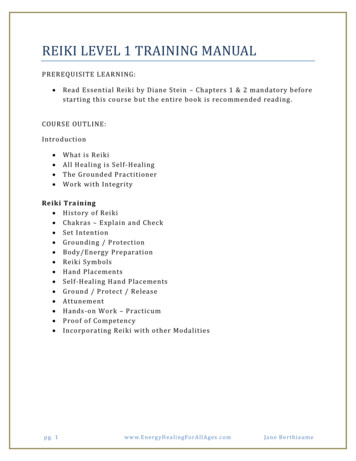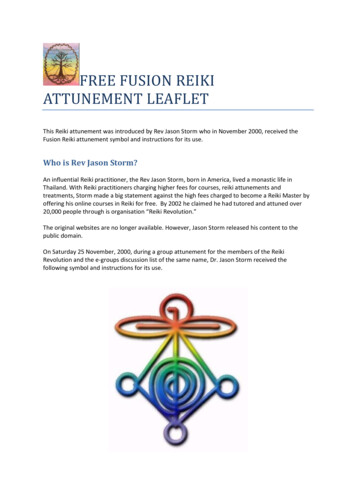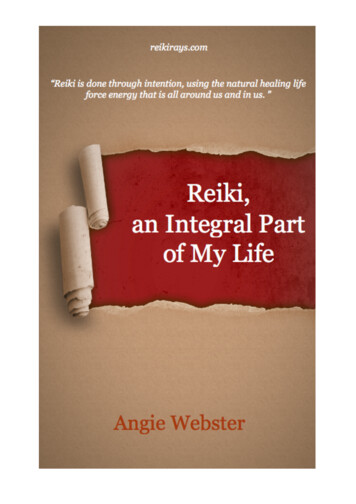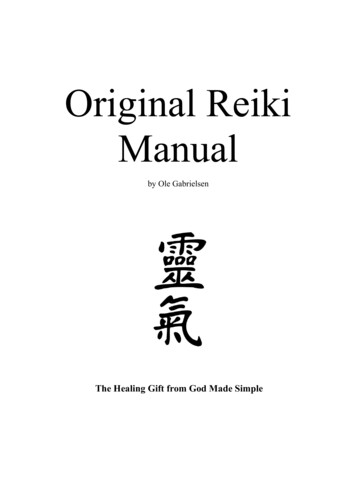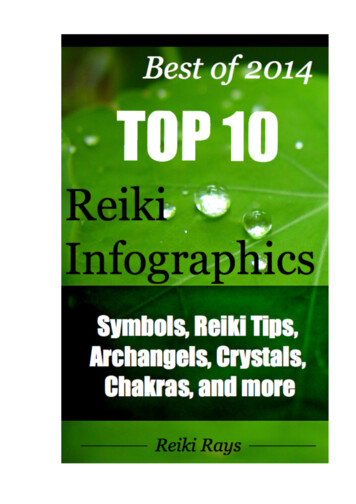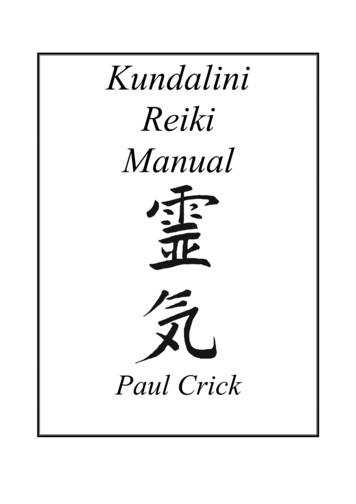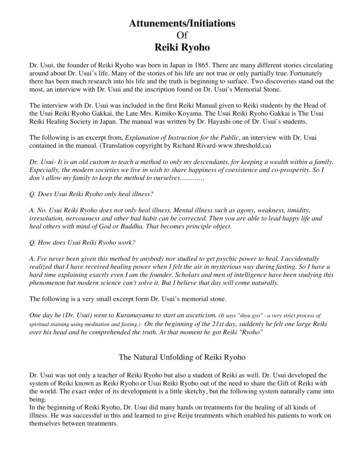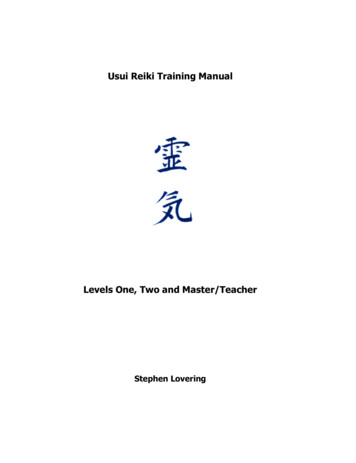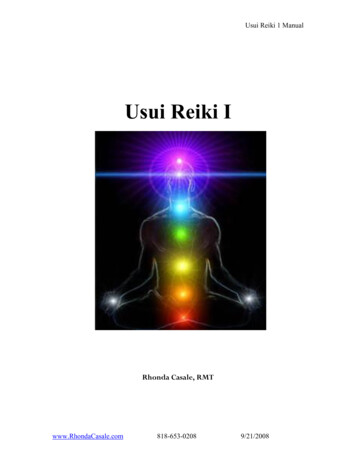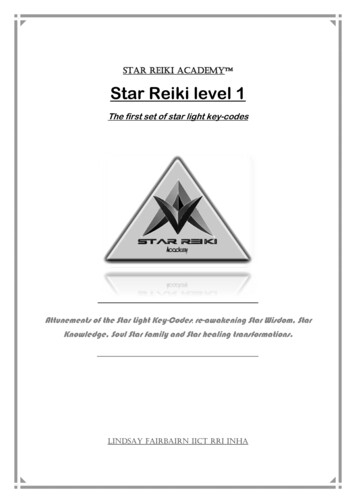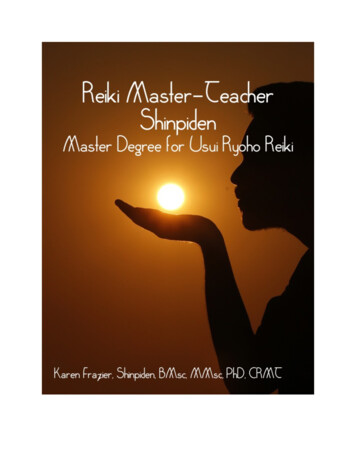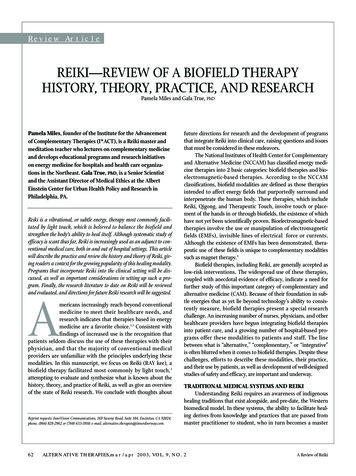
Transcription
Review ArticleREIKI—REVIEW OF A BIOFIELD THERAPYHISTORY, THEORY, PRACTICE, AND RESEARCHPamela Miles and Gala True, PhDPamela Miles, founder of the Institute for the Advancementof Complementary Therapies (I*ACT), is a Reiki master andmeditation teacher who lectures on complementary medicineand develops educational programs and research initiativeson energy medicine for hospitals and health care organizations in the Northeast. Gala True, PhD, is a Senior Scientistand the Assistant Director of Medical Ethics at the AlbertEinstein Center for Urban Health Policy and Research inPhiladelphia, PA.Reiki is a vibrational, or subtle energy, therapy most commonly facilitated by light touch, which is believed to balance the biofield andstrengthen the body's ability to heal itself. Although systematic study ofefficacy is scant thus far, Reiki is increasingly used as an adjunct to conventional medical care, both in and out of hospital settings. This articlewill describe the practice and review the history and theory of Reiki, giving readers a context for the growing popularity of this healing modality.Programs that incorporate Reiki into the clinical setting will be discussed, as well as important considerations in setting up such a program. Finally, the research literature to date on Reiki will be reviewedand evaluated, and directions for future Reiki research will be suggested.mericans increasingly reach beyond conventionalmedicine to meet their healthcare needs, andresearch indicates that therapies based in energymedicine are a favorite choice.1,2 Consistent withfindings of increased use is the recognition thatpatients seldom discuss the use of these therapies with theirphysician, and that the majority of conventional medicalproviders are unfamiliar with the principles underlying thesemodalities. In this manuscript, we focus on Reiki (RAY kee), abiofield therapy facilitated most commonly by light touch, 3attempting to evaluate and synthesize what is known about thehistory, theory, and practice of Reiki, as well as give an overviewof the state of Reiki research. We conclude with thoughts aboutAReprint requests: InnoVision Communications, 169 Saxony Road, Suite 104, Encinitas, CA 92024;phone, (866) 828-2962 or (760) 633-3910; e-mail, alternative.therapies@innerdoorway.com.62future directions for research and the development of programsthat integrate Reiki into clinical care, raising questions and issuesthat must be considered in these endeavors.The National Institutes of Health Center for Complementaryand Alternative Medicine (NCCAM) has classified energy medicine therapies into 2 basic categories: biofield therapies and bioelectromagnetic-based therapies. According to the NCCAMclassifications, biofield modalities are defined as those therapiesintended to affect energy fields that purportedly surround andinterpenetrate the human body. These therapies, which includeReiki, Qigong, and Therapeutic Touch, involve touch or placement of the hands in or through biofields, the existence of whichhave not yet been scientifically proven. Bioelectromagnetic-basedtherapies involve the use or manipulation of electromagneticfields (EMFs), invisible lines of electrical force or currents.Although the existence of EMFs has been demonstrated, therapeutic use of these fields is unique to complementary modalitiessuch as magnet therapy.4Biofield therapies, including Reiki, are generally accepted aslow-risk interventions. The widespread use of these therapies,coupled with anecdotal evidence of efficacy, indicate a need forfurther study of this important category of complementary andalternative medicine (CAM). Because of their foundation in subtle energies that as yet lie beyond technology’s ability to consistently measure, biofield therapies present a special researchchallenge. An increasing number of nurses, physicians, and otherhealthcare providers have begun integrating biofield therapiesinto patient care, and a growing number of hospital-based programs offer these modalities to patients and staff. The linebetween what is “alternative,” “complementary,” or “integrative”is often blurred when it comes to biofield therapies. Despite thesechallenges, efforts to describe these modalities, their practice,and their use by patients, as well as development of well-designedstudies of safety and efficacy, are important and underway.TRADITIONAL MEDICAL SYSTEMS AND REIKIUnderstanding Reiki requires an awareness of indigenoushealing traditions that exist alongside, and pre-date, the Westernbiomedical model. In these systems, the ability to facilitate healing derives from knowledge and practices that are passed frommaster practitioner to student, who in turn becomes a masterALTERNATIVE THERAPIES,mar/apr 2003, VOL. 9, NO. 2A Review of Reiki
practitioner. Such lineages of healers are seen across cultures andshare common threads; however, there are always cultural andidiosyncratic variations. The indigenous traditions of China,Tibet, Africa, Russia, Native America, and India (Ayurveda) areknown in the West. In Europe, the Iceman who died 5300 yearsago in the Swiss Alps and was recently discovered frozen in a glacier was noted to have parasites in his intestines. He carried a medicine pouch and was deemed to be self-medicating with localmushrooms. If this is true, the Iceman clearly had access to medical information through non-scientific means.5Although some indigenous and traditional medical systems are known to have used advanced medical technologiessuch as brain surgery in India and Africa, these systems oftenemphasize the development of skills in areas overlooked in conventional medicine. For example, traditional healers use remedies from the natural environment and focus on accessing thesubtle vibrational field, which is understood to be related toconsciousness. Intervening in the vibrational field is deemednecessary for lasting benefit. The training of traditional healersrequires they become adept in navigating subjective realms ofawareness, a skill developed through meditative techniques anddisciplined spiritual practice.HISTORYMikao Usui (1865-1926), a lifelong practitioner of TendaiBuddhism and dedicated spiritual aspirant, formulated the rootsof what has come to be called Reiki in early 20th century Japan.He trained in a monastery as a young boy, and practiced martialarts from age 12, achieving mastery in several disciplines. Perhapsbecause of Usui’s background in Buddhism, Reiki is often referredto as an ancient Tibetan technique, although there is no evidencethat this is true. Mikao Usui clearly referred to himself as thefounder of Reiki6 and Tibetan medicine does not include handson energetic healing.Those who approached Usui for healing were given a fewminutes of light healing touch before being instructed in hismethod of spiritual self-development. The first level of teachingwas freely given. Thereafter, students had to earn other levelsthrough disciplined practice. Each student was taught accordingto his nature, dedication, and accomplishment. Usui’s philosophy was non-dualist, and he stressed spiritual unfolding throughregular practice of spiritual techniques which included the use ofsymbols in ways reminiscent of Taoist talismanic healing images.His teaching was a system of spiritual practice; any physical,emotional, or mental healing that might occur was seen as a natural by-product (personal communication, Kenneth Cohen,December 2002). Students referred to the teachings as UsuiTeate (Usui Hand Touch or Usui Hand Healing). Usui stressedthe importance of peaceful mental demeanor, and offered hisstudents 5 precepts to guide them:Just for today, do not anger.Just for today, do not worry.Be humble.A Review of ReikiBe honest in your work.Be compassionate to yourself and others.In the last year of his life, Usui was approached by his student Chujiro Hayashi (1878-1940), a retired naval officer, with arequest to develop the therapeutic aspects of the system separatefrom the stringent meditative practices. Usui agreed. After Usui’sdeath, Hayashi further developed the system as a practical healing technique without the perceived encumbrance of spiritualpractices. He called his technique Hayashi Shiki Reiki, andalthough Usui sometimes used the word, it is likely from Hayashithat the system came to be called Reiki, Rei meaning universal orhighest and Ki meaning subtle energy,7 like the Chinese chi. (Itshould be noted the vibration accessed in Reiki arises from nondual primordial chi, or Tao, as distinguished from the bioenergetic level of chi stimulated by therapeutic acupuncture.) 8Although Hayashi’s technique was simplified from Usui’s systemof spiritual practices, his use of the word Reiki implied that evenwith his modifications, the healing technique remained rooted inspirituality, that he was accessing the same non-dual consciousvibration for healing.Hayashi opened a small 8-bed clinic in Tokyo where 16practitioners gave Reiki treatment in pairs. At some point,Hayashi diverged from Usui’s typically Buddhist approach ofmaking teachings and healing available at a low monetary cost,noting that people were more engaged when paying fees fortheir healing.6,9 As Reiki became available beyond the circle ofspiritual aspirants, it entered the medical marketplace and theissue of compensation for both training and treatment had tobe addressed.Mrs Hawayo Takata (1900-1980), a first generation American,came to Hayashi’s clinic in 1936 suffering from respiratory andabdominal complaints.9 After receiving treatment for 4 monthsand recovering her health,10 she became his student and practicedin his clinic. Takata returned home to Hawaii in 1937, carryingHayashi’s instruction to bring Reiki to the West. Hayashi visitedHawaii in 1938, teaching and lecturing, and trained Takata to be aReiki master. Hayashi signed a certificate on February 21, 1938attesting that Takata was a fully credentialed Reiki master—theonly one outside Japan at the time, and the first woman. Hayashiunderstood deeply that Usui wanted the teachings to be widelyaccessible, and was emboldened to step beyond the cultural tradition that would have restricted the practice to Japanese men.Faced with the challenge of articulating a Japanese healingtechnique to a largely Christian population in the socio-politicalclimate preceding World War II, Takata pragmatically reshapedthe origins of Reiki, presenting Usui as a Christian minister.6,9She did not, however, vary the practice from what Hayashi hadtaught, emphasizing the foundation of consistent self-treatment. Takata taught and shared Reiki for many years in Hawaii.In 1973 she was invited to the mainland, where she taught forthe last 7 years of her life. Takata died in December 1980, havinginitiated 22 Reiki masters (Hayashi and Usui each trainedapproximately 18).ALTERNATIVE THERAPIES,mar/apr 2003, VOL. 9, NO. 263
In less than 15 years after her death, Reiki had spreadaround the world and returned to Japan, although rarely according to the guidelines she taught. In the mid 1990s, severalWestern Reiki masters discovered a small group of students whowere originally trained by either Usui or Hayashi. One of thesestudents clarified the distinction between vibrational and bioenergetic healing by saying: “Usui-sensei told [us] that [the] methodis a spiritual healing technique and an energy healing technique.Spiritual healing brings fundamental healing by helping us tobecome part of the universal consciousness, while energy healingcenters around removing the symptoms of mind and body disorders.”6 Advanced practitioners of biofield therapies, includingReiki, conceptualize the biofield as a continuum from the vibrational, at the deepest and subtlest level, to the bioenergetic, closerto the physical realm. While this distinction has not been scientifically tested, it is important within the system of Reiki healingand essential to the theory behind Reiki, as will be discussedbelow. The term Reiki refers to both the healing system and thevibration accessed.Nearly all Reiki practitioners outside of Japan today tracetheir lineage to the 22 masters trained by Takata. There are alsotwo other teachers, Hiroshi Doi and Premaratna, who offer disciplined practices descended from Usui and Hayashi. This paperuses the term Reiki to refer to the traditional technique as taughtby Takata, unless otherwise specified. In accordance with the philosophy of Asian spiritual practices in which the practitioner isalways seen as a student of the system and a “master” properlythinks of himself as a “master student,” we use the terms “practitioner” and “student” interchangeably.TRADITIONAL REIKI TREATMENTHands-on Reiki treatment is offered through light touch on afully clothed recipient seated in a chair or reclining on a treatment table. A quiet setting conducive to relaxation is desirable,but not necessary. A full treatment typically includes placinghands on 12 positions on the head, and on the front and back ofthe torso. Hands can also be placed directly on the site of injuryor pain if desired, but the technique is neither symptom norpathology specific.11 When even light touch is contraindicated, asin the presence of lesions, the hands can hover inches off thebody.12 A session can be as short or as long as needed,9 with fulltreatments typically lasting 45 to 75 minutes. The receiver neednot be conscious13 and Reiki can be offered during surgery.11 Thepractice of Reiki is primarily passive, embodying the Asian philosophy of non-action.14 Offering Reiki is refreshing to the practitioner as well as the recipient. Practitioners believe Reiki has thepotential to rebalance the biofield at the deepest vibrational level,thereby removing the subtle causes of illness9 while enhancingoverall resilience. Because Reiki is a holistic modality that supports overall healing and well-being, it is not possible to predicthow quickly specific symptoms may respond. Generally, inaddressing chronic conditions, a minimum of 4 complete treatments is advised before evaluating clinical benefit.64REIKI TRAININGReiki is practiced at the First degree, Second degree, andmaster level, with each level having a defined scope of practice. Atthe core of the training, and unique to this practice, is a series ofinitiations, also called empowerments or attunements, which arebelieved to connect the student to primordial consciousness, theintelligence that permeates creation, maintaining life-sustainingfunctions and directing complex cellular processes, and which isthe source of subtle Reiki vibration.7 This connection is believedthen to be available at any time, regardless the student’s health,mental state or intention. Self-treatment is viewed as the foundational practice for all levels.9 Reiki practice is considered selfrevealing, and students are not taught Reiki as much as they aretaught how to learn Reiki. Initiation at each level marks thebeginning of study at that level, not the culmination of learning.6,9First degree Reiki is easily learned12 and appropriate for students of any age or state of health who have the desire to practice.First degree students are able to treat themselves and othersusing light, non-manipulative touch to precipitate a cascade ofhealing vibration. The effectiveness of the treatment and therecipient’s ability to discern the energy do not seem to be related.15 It is advisable to practice a minimum of 3 months beforeproceeding to Second degree.3Second degree practitioners are trained in the use of specificsymbols to access Reiki mentally for distant healing. First andSecond degree training require 8 to 12 hours of class time eachand are usually taught to groups, although private instructionmay be arranged. There are 4 initiations in First degree, and 1 initiation for each of the 2 remaining levels.3At all levels, Reiki develops through committed practice. It isnot necessary, nor is it advisable, to take higher initiations toimprove one’s practice. The reason to study another level is toacquire that particular skill—distant healing at Second degree, orteaching and initiation at the master level. At any level, studentscan only advance through diligent self-treatment. In this way,Reiki masters have not mastered Reiki; they are simply studentswho feel called to teach, and who continue to learn throughteaching. True mastery, in the sense of Usui, Hayashi, and Takata,is not a matter of receiving an initiation, but rather a life committed to practice.3Practicing Reiki 3 to 10 years creates a reasonable foundation for teaching. Master training is an apprenticeship of at leasta year.3 When teaching at any level, it is the Reiki master’s responsibility to consider any unusual circumstances and use his or herdiscretion in customizing the training to fit the individual.6 Reikiis learned through direct transmission from a Reiki master andcannot be learned from a book.3 None of the traditional Reiki levels include training in either professional treatment or thedynamics of the therapeutic relationship.The training described above is the ideal based on Takata.However, since her death in 1980, many Reiki students have notreceived such thorough training. Today, it is common for newstudents to receive less than a weekend of training and leave withthe misguided impression they are now Reiki masters. One canALTERNATIVE THERAPIES, mar/apr 2003, VOL. 9, NO. 2A Review of Reiki
only grow in mastery through years of disciplined practice.Although there are several professional organizations forReiki masters, the Reiki Alliance adheres most consistently to thestandards set by Takata. It has more than 700 members in 45countries who honor a code of ethics that includes respecting thephysician/patient relationship.3 There are also Reiki masters notaffiliated with the Reiki Alliance who are committed to ethicalpractice and the complete training and initiation of new students.It is important to note that no certificate conveys reliable information about quality of training. Thus, it is useful to include anumber of factors when considering a Reiki practitioner’s credentials, such as consistency of self-treatment, extent of clinical practice, and length of time between training at different levels. Theseissues are addressed in other sections of this article.REIKI THEORYThere is no agreed upon theory for how Reiki might work,and its mechanism of action is still unknown. For this reason,Reiki is subject to the criticism leveled at other CAM modalitiesby skeptics: it cannot be efficacious because it lacks a known biological mechanism of action. As David Hufford has argued,implicit in this view is the belief that CAM claims will be provento be ‘true’ or ‘false’ on the basis of present scientific knowledge,and that “the acceptance of any theoretically implausible claimswould require the abandonment of current scientificknowledge.”16 This of course ends all inquiry before it begins,leaving no room for making connections between theories underlying energy healing practices such as Reiki, Therapeutic touch,or Qi gong, and those emerging in various branches of the conventional sciences.The concepts underlying energy therapies such as Reiki havetheoretical commonalities with a variety of models in physics,none of which have been experimentally linked with medicine orclinical outcomes. Models in bioelectromagnetism, quantumphysics,17 and super string theory18 are consistent with Asianscripture19-23 in suggesting that very subtle vibration may be thesubstratum of reality as we know it, and therefore such vibrationmay have a role to play in health and disease. For example, JanWalleczek24 and Abe Liboff25 in the field of bioelectromagnetismoffer credible scientific support for the potential role of the forcesof subtle bioelectromagnetic fields in physiological processes.Walleczek in particular has convincingly demonstrated that subtle magnetic fields can have measurable interactions with biological systems in the area of redox potential and hydroxylationreactions. Although this area of research is in its early stages,these connections suggest that the theoretical underpinnings ofReiki and other energy therapies may not be in direct contradiction to scientific models.Reiki vibration is understood to be drawn through the practitioner according to the recipient’s need,26 within the ability ofthe practitioner to carry the vibration. Beginning students oftenfind it difficult to grasp that non-doing can be so effective. Theflow of Reiki is believed to increase as the practitioner becomesinwardly more still, an understanding acquired only through pro-A Review of Reikilonged practice. The fact that the vibrational flow is drawn by therecipient allows for great flexibility and ease of delivery. While apractitioner’s ability to be a conduit for the vibrations may vary,there is ultimately no wrong technique.9 Reiki’s self-regulatorymechanism precludes “overdosing”—even a dry sponge onlyabsorbs to saturation. Experienced practitioners claim to noticewhen the healing vibrational flow decreases, at which time theymove to the next hand placement.27 Recipients often sense a vibrational flow, sometimes feeling heat or coolness, or waves of relaxation throughout their body, or in specific areas that may or maynot correspond to where the practitioner’s hands are placed.26-28Such experiences may be evidence of a subtle entrainment effect,similar to that of sound healing, whereby Reiki vibrations attunethe recipient’s biofield to greater harmony.Reiki is believed to rebalance the biofield, thus strengthening the body’s ability to heal29 and increasing systemic resistanceto stress. It appears to reduce stress and stimulate self-healing byrelaxation and perhaps by resetting the resting tone of the autonomic nervous system. Proponents of Reiki believe this mightlead to enhancement of immune system function and increasedendorphin production.Programs Currently Incorporating Reiki into Clinical CareTable 1 provides a summary of programs that incorporateReiki into the clinical setting. The majority of these programshave not been subject to systematic evaluation due to budgetaryand time constraints. However, staff, patients, and programadministrators report a number of benefits including reducedanxiety and lower use of pain medications, increased patient satisfaction for surgical patients,29 and decreased numbers of selfreported common gerontological complaints such as anxiety,loneliness, insomnia, and pain among older individuals living inthe community. Reiki can easily fit within the harm reductionmodel30 and can be successfully used in self-treatment in combination with appropriate medical/psychiatric care by people withcombined HIV and psychiatric diagnoses for emotional centering, pain management, and support in recovery readiness.Children with cancer and their families practice First degree Reikion themselves and one another. Reiki is a supportive therapy forhospice and palliative care.31OVERVIEW OF REIKI IN CLINICAL PRACTICEAlthough Reiki was first used in lay practice, it is increasingly used in a variety of medical settings including hospice care settings;26,31 emergency rooms;32 psychiatric settings;33operatingrooms;29,34 nursing homes;35 pediatric,12 rehabilitation;35 and family practice centers, obstetrics, gynecology, and neonatal careunits;36 HIV/AIDS;37,38 and organ transplantation care units;38and for a variety of medical conditions such as cancer; 3 9pain;27,29,34 autism/special needs; infertility; neurodegenerativedisorders; and fatigue syndromes. Reiki’s popularity among thelay population is evidenced by its mention in a wide variety ofpublications from the New York Times and Time, to Esquire andTown & Country.ALTERNATIVE THERAPIES, mar/apr 2003, VOL. 9, NO. 265
TABLE 1 Reiki hospital and community based programsProgramGENERAL MEDICINEWilcox Memorial HospitalLihue, Kauai, HawaiiCenter for Mind & Body MedicineMid-Columbia Medical CenterThe Dalles, OrePortsmouth Regional HospitalPortsmouth, NHCenter for Integrative MedicineGeorge Washington University HospitalWashington, D.C.HIV/AIDSSamuels Center for Comprehensive CareSt. Lukes-Roosevelt Hospital CenterNew York, NYSiloamPhiladelphia, PaCANCERDireccion de Servicios Metropolitano Sur(Metropolitan South Health Center) (6 hospitals serving 7000 people)Santiago, ChileIntegrative Therapies Program for Children with Cancer ColumbiaPresbyterian Medical CenterNew York, NYDartmouth Hitchcock Medical CenterLebanon, NHIntegrative Medicine Outpatient CenterMemorial Sloan Kettering Cancer CenterNew York, NYSURGERYMercy HospitalPortland, MeCOMMUNITY PROGRAMSAddison Gilbert HospitalGloucester, MassBi-weekly Reiki clinicsQuaLife Wellness CommunityDenver, ColoRespite FoundationNew York, NYWolfeboro Free Clinics13 locations in NH and MeELDER CAREDorotNew York, NYKnox Center for Long Term CareRockland, MeCamden Health Care CenterCamden, Me residents and staff treatmentHOSPICEHospice MauiWailuku, Maui, HIAssured Home Health and HospiceChehalis, WashGood Samaritan Home Health and HospicePuyallup, WashWhidbey General HospitalHome Health & Hospice ProgramCoupville, Wash66Persons ServedServices OfferedPatientsTreatmentStaffTrainingInpatients and OutpatientsTreatmentOutpatientsTreatment and trainingAdults with HIV/AIDS, family membersand caregiversTreatment and trainingPeople with HIV/AIDS and familiesTreatment and trainingChildren with cancerTreatmentChildren with cancer and their familiesTreatment and trainingRadiation oncology patientsTreatmentCancer patientsTreatment and trainingSurgical patients and staffTreatmentCommunityTreatmentPeople with serious illnessesTreatment and trainingFamilies with special needsTreatmentCommunity idents and staffTreatmentPatientsTreatment and trainingPatients, families, caregivers, staffTreatmentIn-patients and out-patientsTreatment and trainingPatientsTreatmentALTERNATIVE THERAPIES, mar/apr 2003, VOL. 9, NO. 2A Review of Reiki
There are 3 tiers of Reiki practice: Individuals who use Reiki for themselves, family, andfriends; Licensed or unlicensed health care professionals eitheroffering full Reiki treatment or combining Reiki with othermodalities (such as a massage therapist starting/endingtreatment with a few minutes of Reiki, or a physician usingReiki to ease the discomfort of an examination); Hospital-affiliated and community-based programs offering Reiki treatment or training.Reiki appears to be an effective stress reduction techniquethat easily integrates into conventional medicine12 because itinvolves neither the use of substances nor manipulative touch thatmight be contraindicated or carry unknown risks, and because theprotocol for Reiki treatment is flexible, adapting to both the needof the patient and of the medical circumstances. Reiki can be usedto support conventional medical interventions.12,27,40 In addition,when used on a conscious patient, the experience is relaxing andpleasant, increasing patient comfort, enhancing relationships withcaregivers, and possibly reducing side effects of procedures andmedications. Staff report they enjoy giving Reiki treatments.12Caregivers who routinely have to hurt patients in order administerneeded medical care express gratitude for a tool that minimizespatient discomfort and quickly soothes distressed children. 29,36There is limited but promising preliminary research evidence forReiki’s use in pain management.First degree practice is easily learned and can be used in selftreatment.26 Training patients to practice Reiki self-treatment mayreduce the side effects of common medical interventions andempower patients with a simple, effective skill to address anxiety,insomnia, and pain26 at modest cost.41 A patient with resources toaddress his own suffering is better equipped to comply with conventional medical protocols and be a responsible partner to hismedical caregivers.11INTRODUCING REIKI INTO CLINICAL PROGRAMS ANDHOSPITALSEven in the absence of a large body of standardizedresearch, clinicians and hospital administrators are includingReiki into patient care.12 With this in mind, we outline some ofthe challenges and issues that are being faced.42There are 3 avenues through which Reiki is being incorporated into conventional medical care: Medical personnel are learning First degree Reiki, using itfor self-care, and integrating comforting touch into routine medical care; Reiki practitioners are offering treatment to patientsand staff; Hospital-based education programs are training patients,family members and caregivers in First degree Reiki.It is a challenge to locate and identify Reiki practitioners whohave the training, clinical experience, and professionalism neces-A Review of Reikisary to be part of a healthcare team.43,44 There is currently nolicensing for Reiki, nor, given its diversity and apparent low-risk,is there likely to be.The first step when bringing Reiki into clinical settings is thedecision to offer treatment or training or both. A Reiki master isneeded if Reiki training will be offered, and a traditionally trainedReiki master who has taken training over several years and hasadditional years of clinical experience is best equipped to set up orsupervise a program. A First or Second degree practitioner whohas adequate training and clinical experience, who values integrative medical collaboration, and who has references from medicalpractitioners is qualified to give treatment.An otherwise qualified Reiki practitioner may need guidanceon how to work in a medical rather than a private practice environment.45 Once expectations are communicated and agreedupon, there may be advantages to using non-medical Reiki practitioners rather than Reiki trained medical professionals whenoffering Reiki to patients. Integrative medicine calls for the incorporation into medical settings of dedicated and experienced layCAM practitioners even when their particular expertise lies outside t
the source of subtle Reiki vibration.7 This connection is believed then to be available at any time, regardless the student's health, mental state or intention. Self-treatment is viewed as the founda-tional practice for all levels.9 Reiki practice is considered self-revealing, and students are not taught Reiki as much as they are
